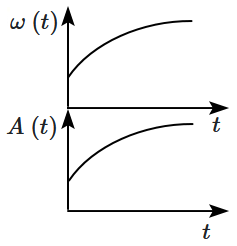A parallel plate capacitor made of circular plates is being charged such that the surface charge density on its plates is increasing at a constant rate with time. The magnetic field arising due to displacement current is:
| 1. | non-zero everywhere with maximum at the imaginary cylindrical surface connecting peripheries of the plates |
| 2. | zero between the plates and non-zero outside |
| 3. | zero at all places |
| 4. | constant between the plates and zero outside the plates |
Subtopic: Displacement Current |
Level 3: 35%-60%
NEET - 2025
Please attempt this question first.
Hints
Please attempt this question first.
An electric dipole with dipole moment \(5\times10^{-6}~\text{C-m} \) is aligned with the direction of a uniform electric field of magnitude \(4\times10^{5}~\text{N/C}. \) The dipole is then rotated through an angle of \(60^\circ\) with respect to the electric field. The change in the potential energy of the dipole is:
1. \(1.2~\text{J}\)
2. \(1.5~\text{J}\)
3. \(0.8~\text{J}\)
4. \(1.0~\text{J}\)
1. \(1.2~\text{J}\)
2. \(1.5~\text{J}\)
3. \(0.8~\text{J}\)
4. \(1.0~\text{J}\)
Subtopic: Energy of Dipole in an External Field |
53%
Level 3: 35%-60%
NEET - 2025
Please attempt this question first.
Hints
Please attempt this question first.
A ball of mass \(0.5~\text{kg}\) is dropped from a height of \(40~\text{m}.\) The ball hits the ground and rises to a height of \(10~\text{m}.\) The impulse imparted to the ball during its collision with the ground is:
(take \(g=9.8~\text{m/s}^2\))
(take \(g=9.8~\text{m/s}^2\))
| 1. | \(0\) | 2. | \(84~\text{N-s}\) |
| 3. | \(21~\text{N-s}\) | 4. | \(7~\text{N-s}\) |
Subtopic: Newton's Laws |
53%
Level 3: 35%-60%
NEET - 2025
Please attempt this question first.
Hints
Please attempt this question first.
The intensity of transmitted light when a polaroid sheet, placed between two crossed polaroids at \(22.5^\circ\) from the polarization axis of one of the polaroids, is (\(I_0\) is the intensity of polarised light after passing through the first polaroid):
| 1. | \(\dfrac{I_0}{8}\) | 2. | \(\dfrac{I_0}{16}\) |
| 3. | \(\dfrac{I_0}{2}\) | 4. | \(\dfrac{I_0}{4}\) |
Subtopic: Polarization of Light |
Level 4: Below 35%
NEET - 2025
Please attempt this question first.
Hints
Please attempt this question first.
The kinetic energies of two similar cars \(A\) and \(B\) are \(100~\text J\) and \(225~\text J\) respectively. On applying breaks, car \(A\) stops after \(1000~\text m\) and car \(B\) stops after \(1500~\text m.\) If \(F_A\) and \(F_B\) are the forces applied by the breaks on cars \(A\) and \(B,\) respectively, then the ratio \(\dfrac{F_A}{F_B}\) is:
1. \(\dfrac{1}{3}\)
2. \(\dfrac{1}{2}\)
3. \(\dfrac{3}{2}\)
4. \(\dfrac{2}{3}\)
1. \(\dfrac{1}{3}\)
2. \(\dfrac{1}{2}\)
3. \(\dfrac{3}{2}\)
4. \(\dfrac{2}{3}\)
Subtopic: Work Energy Theorem |
61%
Level 2: 60%+
NEET - 2025
Please attempt this question first.
Hints
Please attempt this question first.
The current passing through the battery in the given circuit, is:

1. \(2.5~\text{A}\)
2. \(1.5~\text{A}\)
3. \(2.0~\text{A}\)
4. \(0.5~\text{A}\)

1. \(2.5~\text{A}\)
2. \(1.5~\text{A}\)
3. \(2.0~\text{A}\)
4. \(0.5~\text{A}\)
Subtopic: Wheatstone Bridge |
Level 3: 35%-60%
NEET - 2025
Please attempt this question first.
Hints
Please attempt this question first.
Three identical heat conducting rods are connected in series as shown in the figure. The rods on the sides have thermal conductivity \(2K\) while that in the middle has thermal conductivity \(K\). The left end of the combination is maintained at temperature \(3T\) and the right end at \(T.\) The rods are thermally insulated from outside. In the steady state, temperature at the left junction is \(T_1\) and that at the right junction is \(T_2\). The ratio \(\dfrac{T_1}{T_2}\) is:


| 1. | \(\dfrac{5}{3}\) | 2. | \(\dfrac{5}{4}\) |
| 3. | \(\dfrac{3}{2}\) | 4. | \(\dfrac{4}{3}\) |
Subtopic: Conduction |
Level 3: 35%-60%
NEET - 2025
Please attempt this question first.
Hints
Please attempt this question first.
In an oscillating spring mass system, a spring is connected to a box filled with the sand. As the box oscillates, sand leaks slowly out of the box vertically so that the average frequency \(\omega~(t)\) and average amplitude \(A~(t)\) of the system changes with time \(t.\) Which of the following options systemically depicts these changes correctly?
| 1. |  |
2. |  |
| 3. |  |
4. |  |
Subtopic: Spring mass system |
Level 3: 35%-60%
NEET - 2025
Please attempt this question first.
Hints
Please attempt this question first.
\(AB\) is a part of an electrical circuit (see figure). The potential difference \(''V_{A}-V_{B}'',\) at the instant when current \(i=2~\text A\) and is increasing at a rate of \(1~\text{amp/second}\) is:

1. \(9~ \text{volts}\)
2. \(10~ \text{volts}\)
3. \(5~ \text{volts}\)
4. \(6~ \text{volts}\)

1. \(9~ \text{volts}\)
2. \(10~ \text{volts}\)
3. \(5~ \text{volts}\)
4. \(6~ \text{volts}\)
Subtopic: LR circuit |
58%
Level 3: 35%-60%
NEET - 2025
Please attempt this question first.
Hints
Please attempt this question first.
A particle of mass \(m\) is moving around the origin with a constant force \(F\) pulling it towards the origin. If Bohr model is used to describe its motion, the radius \(r\) of the \(n^{\text{th}}\) orbit and the particle's speed \(v\) in the orbit depend on \(n\) as:
| 1. | \(r \propto n^{2/3}; v \propto n^{1/3}\) |
| 2. | \(r \propto n^{4/3}; v \propto n^{-1/3}\) |
| 3. | \(r \propto n^{1/3}; v \propto n^{1/3}\) |
| 4. | \(r \propto n^{1/3}; v \propto n^{2/3}\) |
Subtopic: Bohr's Model of Atom |
Level 3: 35%-60%
NEET - 2025
Please attempt this question first.
Hints
Please attempt this question first.






